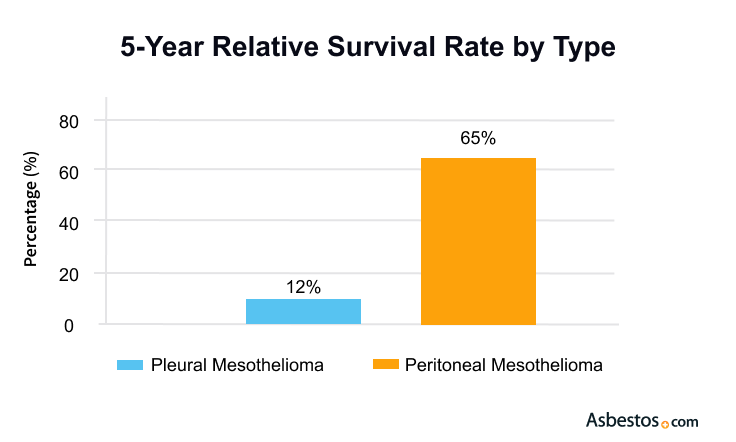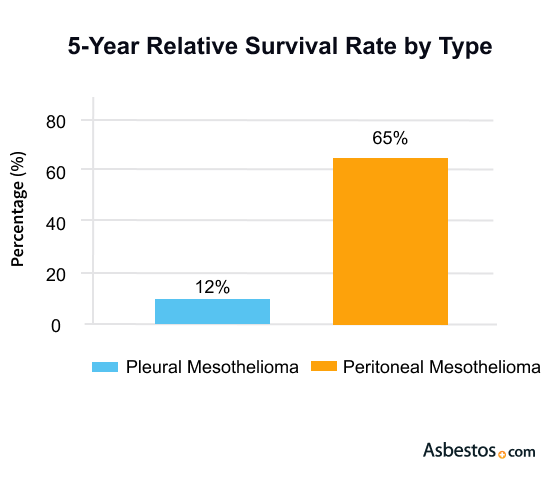Based on Your Reading:
Get Your Free Mesothelioma Guide

Find a Top Mesothelioma Doctor

Access Help Paying for Treatment

The 5-year survival rate for peritoneal mesothelioma is 65% and for pleural mesothelioma it's 12%. Survival across mesothelioma types is typically 18 months with treatment. Some patients have survived more than 10 years because of early detection, their overall health and treatment.
Written by Karen Selby, RN • Edited By Walter Pacheco • Medically Reviewed By Dr. Rupesh Kotecha
The Mesothelioma Center at Asbestos.com has provided patients and their loved ones the most updated and reliable information on mesothelioma and asbestos exposure since 2006.
Our team of Patient Advocates includes a medical doctor, a registered nurse, health services administrators, veterans, VA-accredited Claims Agents, an oncology patient navigator and hospice care expert. Their combined expertise means we help any mesothelioma patient or loved one through every step of their cancer journey.
More than 30 contributors, including mesothelioma doctors, survivors, health care professionals and other experts, have peer-reviewed our website and written unique research-driven articles to ensure you get the highest-quality medical and health information.
My family has only the highest compliment for the assistance and support that we received from The Mesothelioma Center. This is a staff of compassionate and knowledgeable individuals who respect what your family is experiencing and who go the extra mile to make an unfortunate diagnosis less stressful. Information and assistance were provided by The Mesothelioma Center at no cost to our family.LashawnMesothelioma patient’s daughter


Selby, K. (2024, April 18). Mesothelioma Survival Rates. Asbestos.com. Retrieved April 26, 2024, from https://www.asbestos.com/mesothelioma/survival-rate/
Selby, Karen. "Mesothelioma Survival Rates." Asbestos.com, 18 Apr 2024, https://www.asbestos.com/mesothelioma/survival-rate/.
Selby, Karen. "Mesothelioma Survival Rates." Asbestos.com. Last modified April 18, 2024. https://www.asbestos.com/mesothelioma/survival-rate/.
The average 5-year survival rate stands at 12% for pleural mesothelioma. However, it’s important to note that some patients have surpassed the 10-year mark.
Peritoneal mesothelioma has a higher survival rate of 65% over a 5-year period. This demonstrates how some people can live many years with this rare and aggressive cancer.


Mesothelioma survival rates also vary depending on the cancer stage, individual patient health and treatments selected. The most successful mesothelioma treatments include surgery, chemotherapy, radiation and immunotherapy.
The National Cancer Institute publishes mesothelioma survival data every few years. It’s the Surveillance, Epidemiology and End Results Program, also known as SEER.
Relative survival is how long people with a certain condition live compared to others in the general population who don’t have the condition. A 5-year survival rate represents the percentage of people who are alive 5 years after diagnosis with cancer.
The rate is used because it provides a standardized benchmark for assessing how long people live with cancer. It helps to measure how well treatments work and disease progression.
For people with mesothelioma, survival rates offer insight into their likelihood of long-term survival and aids in decision-making regarding treatment. The data helps guide patients and health care providers in understanding the potential outcomes of treatment.
Doctors use mesothelioma survival rate data when evaluating a patient’s prognosis. This data averages patient survival time based on thousands of cases. It can’t predict a person’s individual outcome, but it can help people understand what happened to other patients with a similar diagnosis.
There have been people who survived way beyond what the statistics say. I plan on being one of those. I have a lot of people counting on me being around. I’m not going to disappoint them.
Survival rate data is one piece of the puzzle when a doctor determines the best mesothelioma treatment for a patient. For example, statistics show better survival rates among people diagnosed at a younger age. This translates into more aggressive treatment options for younger patients.
Depending on the course of treatment you choose and your circumstances, you may live longer than survival rates suggest. The 5-year survival rates don’t take into consideration the most recent advances in medicine.
Statistics may be a source of comfort for some people and confusing or frightening for others. But survival rates only consider people diagnosed in the past. Those diagnosed today may have more available treatment options and a better chance of survival.
“We had been living a ‘live the year’ type of thing. But after recovery … now it’s not only that we have a bucket list, now we have a ‘we’re going to do this’ list,” mesothelioma survivor Brunilda Villareal told The Mesothelioma Center at Asbestos.com. “Tomorrow is very important – it’s sacred.”
Patients may wish to focus on their treatment plan and let their doctor provide more personalized information. Advances in treatment help some patients live beyond average survival rates.
Get Your Free Mesothelioma Guide

Find a Top Mesothelioma Doctor

Access Help Paying for Treatment

Factors affecting a person’s mesothelioma cancer survival rate include their general health, tumor location and cell type. These affect how long a person will live after a mesothelioma diagnosis.
Women and younger patients tend to live longer. Patients with peritoneal tumors, early-stage disease, epithelioid cells and a history of multimodal therapy also tend to live longer.
Peritoneal mesothelioma survival rates are significantly better than rates for pleural disease. About 65% of all peritoneal mesothelioma patients survive for 5 years or more. Five times more peritoneal patients achieve 5-year survival than pleural patients. Eligible patients with asbestos-related cancer in the peritoneum live between 40 months and 92 months with HIPEC surgery.
| Year(s) | Pleural | Peritoneal |
|---|---|---|
| 1 year | 73.1% | 91.6% |
| 3 years | 22.9% | 73.8% |
| 5 years | 12% | 65.3% |
| 10 years | 4.7% | 39.4% |
These stats are the most recently available. They come from a 2015 study published in Translational Oncology that analyzed 20 years of data.
Women with mesothelioma appear to survive longer than men regardless of age, cancer stage, race or type of treatment. The 5-year relative survival rate for pleural mesothelioma is 23.2% for women compared to 9% for men.
| Gender | 1 Year | 3 Years | 5 Years |
|---|---|---|---|
| Females | 59.3% | 34.5% | 23.2% |
| Males | 49.6% | 22.1% | 9% |
There are several possible reasons why women survive longer than men that researchers are exploring. Women are also more likely to be diagnosed with peritoneal mesothelioma. This mesothelioma type has better survival than pleural tumors. This skews survival rates to favor women living longer on average.
Younger people diagnosed with mesothelioma have higher survival rates compared with people diagnosed at an older age. About 83% of the patients diagnosed before age 50 live for 1 year. About 50% of patients diagnosed at 65 years old or older live the same amount of time.
| Age Range | 1-Year Survival Rate |
|---|---|
| < 50 | 83% |
| 50 – 64 | 53.2% |
| 65+ | 49.6% |
Younger patients tend to be healthier than older patients. That means they’re eligible for more aggressive and effective therapies. Those who are younger are also less likely to be diagnosed with coexisting chronic conditions such as pulmonary disease, diabetes or a history of other cancers.
Change the body copy to: Pleural mesothelioma survivor Kevin Sinyard far surpassed the average mesothelioma survival rate. He was initially told he only had 6 months to live before undergoing extrapleural pneumonectomy surgery. He then underwent aggressive chemotherapy and radiation regimens. Kevin told us, “I’m proof that you can survive and still live a really good life.”
The stage of mesothelioma at diagnosis is a strong predictor of overall survival. The SEER Program groups cancer survival rates into localized, regional and distant stages. This grouping distills the 4 pleural mesothelioma stages into 3, with localized representing stage 1, regional roughly representing stages 2 and 3, and distant representing stage 4.
| SEER Stage | Pleural Mesothelioma 5-Year Relative Survival Rate | Peritoneal Mesothelioma 5-Year Relative Survival Rate |
|---|---|---|
| Localized | 22.5% | 87% |
| Regional | 15.6% | 53% |
| Distant | 9.3% | 29% |
Early-stage patients who receive prompt treatment experience improved survival. They’re more likely to qualify for surgery and other aggressive treatments. More aggressive therapies are associated with better outcomes.
The types of cells that make up tumors impacts patient survival. Mesothelioma has three cell types: Epithelioid, sarcomatoid and biphasic.
Average survival for epithelioid patients is 18 months. Patients with a sarcomatoid diagnosis have a survival range of approximately 6 to 8 months. Those with biphasic cells live an average of 13 months, but it can range depending on the ratio of cells present.
| Predominant Cell Type | Median Survival in Months |
|---|---|
| Epithelial | 18 months |
| Sarcomatoid | 5.4 months |
| Biphasic | 16.2 months |
Biphasic tumors have epithelioid and sarcomatoid features. More epithelial cells mean a better prognosis for mesothelioma patients. If the cancer is primarily sarcomatoid cells, mesothelioma life expectancy decreases.

Mesothelioma patients with a history of smoking, heavy alcohol use or poor diet tend to have lower survival rates. Coexisting conditions, such as heart disease and diabetes, can affect survival as well.
Good nutrition and exercise habits can positively impact survival. A healthy diet and regular exercise help patients respond better to cancer treatment.
Genes and family history also play a role. More than 90% of mesothelioma cases occur in white men, but Black patients have a nearly 7% better 5-year survival rate.
Many long-term mesothelioma survivors attribute their survival to multidisciplinary care or clinical trials. Others say lifestyle changes, such as nutritional improvements, helped them after diagnosis.
A recent study of pleural patients who received surgery, chemotherapy and radiation lived around 21.7 months. Those who decided against treatment reported an overall survival of 10.2 months. Patients with better nutritional status lived an average of 18 months compared to 11 months among those with poor nutritional status, according to another study published in the Journal of Cancer Research and Clinical Oncology.
Patients should avoid measuring their quality of life by mesothelioma survival statistics alone. A 5-year survival rate doesn’t describe how cancer symptoms may impact your quality of life.
“What frustrates me the most, and I hear this almost every time I have a new patient … ‘I just saw my doctor today and they said I have a year to 16 months to live.’ That is just not the case,” says registered nurse and Patient Advocate Karen Selby. “You’re an individual. This is your story.”
The 5-year survival rate for pleural mesothelioma is approximately 12%. The 5-year survival rate for peritoneal mesothelioma is 65%.
Malignant mesothelioma is an aggressive and fatal disease, however, some patients have survived more than 10 years after their diagnosis. While there is no cure for this cancer, there have been advances in care. Most mesothelioma patients only survive approximately 12 months after diagnosis, but treatment may extend mesothelioma survival.
Survival rate is the percentage of cancer patients who live a number of years after diagnosis. For example, 25.6% of mesothelioma patients live for 3 years or more. The mesothelioma mortality rate is the number of deaths within specific geographical locations and groups of people. For example, as of 2020, there were 0.8 deaths from mesothelioma per 100,000 people in the United States.
The 5-year survival rate for mesothelioma patients is approximately 12%. The 5-year survival rate for lung cancer patients is about 26.6%.
People who have underlying health conditions like heart disease, diabetes and high blood pressure are at risk of complications with mesothelioma surgery, chemotherapy and radiation. These conditions may exclude some patients from surgery, which is the most effective treatment to extend survival.

Have a question? Contact one of our Patient Advocates and get the answers you need.

Connect, share stories and learn from the experiences of others coping with mesothelioma in one of our support groups.

We help support charities, hospitals and awareness groups working to help people impacted by asbestos and cancer.
Your web browser is no longer supported by Microsoft. Update your browser for more security, speed and compatibility.
If you are looking for mesothelioma support, please contact our Patient Advocates at (855) 404-4592
